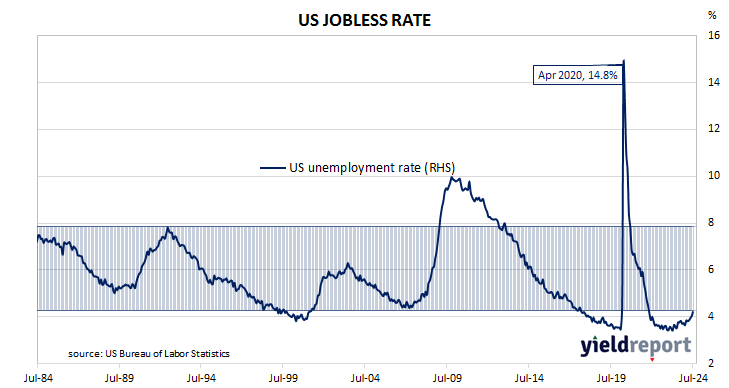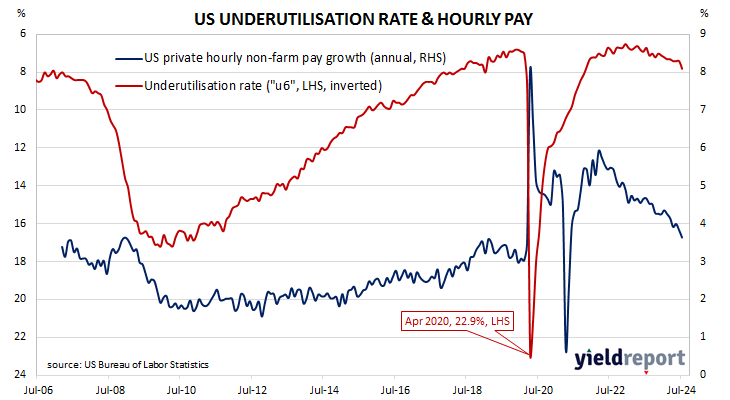Summary: US non-farm payrolls up 114,000 in July, below expectations; previous two months’ figures revised down by 29,000; jobless rate rises to 4.3%, participation rate ticks up to 62.7%; Citigroup: labour market reaching point of further non-linear weakening; US Treasury yields dive; expectations of Fed rate cuts harden; employed-to-population ratio slips to 60.0%; underutilisation rate rises to 7.8%; annual hourly pay growth slows to 3.6%.
The US economy ceased producing jobs in net terms as infection controls began to be implemented in March 2020. The unemployment rate had been around 3.5% but that changed as job losses began to surge through March and April of 2020. The May 2020 non-farm employment report represented a turning point and subsequent months provided substantial employment gains which have continued to the present.
According to the US Bureau of Labor Statistics, the US economy created an additional 114,000 jobs in the non-farm sector in July. The increase was considerably less than the 206,000 rise which had been generally expected as well as the 179,000 jobs which had been added in June. Employment figures for June and May were revised down by a total of 29,000.
The total number of unemployed increased by 352,000 to 7.163 million while the total number of people who were either employed or looking for work increased by 419,000 to 168.429 million. These changes led to the US unemployment rate rises from 4.1% in June to 4.3%. The participation rate ticked up from 62.6% to 62.7%.
“The more-rapid rise in the unemployment in the last few months, which is now accompanied by clearer slowing in payroll job growth, is consistent with a labour market reaching a point of further non-linear weakening,” said Citigroup senior economist Veronica Clark.
US Treasury bond yields dived across the curve on the day, with falls heaviest at the short end. By the close of business, the 2-year yield had plunged 27bps to 3.88%, the 10-year yield had shed 19bps to 3.79% while the 30-year yield finished 17bps lower at 4.11%.
In terms of US Fed policy, expectations of a lower federal funds rate in the next 12 months hardened, with around eight 25bp cuts currently factored in. At the close of business, contracts implied the effective federal funds rate would average 5.11% in September, 22bps less than the current spot rate, 4.535% in November and 4.305% in December. July 2025 contracts implied 3.28%, 205bps less than the current rate.
One figure which is indicative of the “spare capacity” of the US employment market is the employment-to-population ratio. This ratio is simply the number of people in work divided by the total US population. It hit a cyclical-low of 58.2 in October 2010 before slowly recovering to just above 61% in early 2020. July’s reading slipped from 60.1% to 60.0%, some way from the April 2000 peak reading of 64.7%.
Apart from the unemployment rate, another measure of tightness in the labour market is the underutilisation rate and the latest reading of it registered 7.8%, up from 7.4% in June. Wage inflation and the underutilisation rate usually have an inverse relationship; private hourly pay growth in the year to July slowed from 3.8% to 3.6%.



